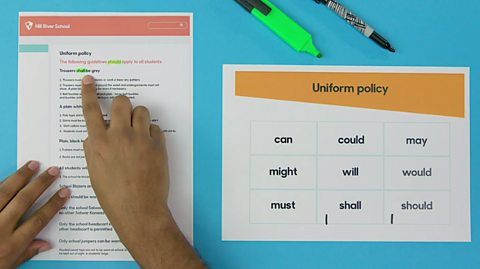Did you know?
One single sentence can be made up of thousands of words
…or just one word!
Introduction
Writers choose and build different types of sentences carefully. There are three main types of sentence structure - simple sentenceA sentence containing one clause made up of a subject and a verb., compound sentenceA sentence which has at least two main clauses joined together with a conjunction. The two, or more, clauses of the sentence still make sense on their own. and complex sentenceA sentence that contains a main (independent) clause and one or more subordinate (dependent) clauses which add extra detail or information to the main clause..
Using complex sentences can make it easier to add layers of information and detail when writing.
Complex sentences have at least one subordinate clause that adds more detail and information to the sentence.
A video about the different types of sentences
Learn the differences between simple, compound and complex sentences
Different sentence types
There are many different sentence types. The three main types of sentences are simple, compound and complex. All three have an equally important role in writing.
Simple sentences
Simple sentences have just one main verbA verb is a word that shows an action (physical or mental) or state of being. , for example:
He walked quickly back to the house.
Simple sentences are important for making clear points. They are also useful for creating tension when writing fiction. However, too many simple sentences can make writing seem disjointed. To hold a reader’s interest, it’s important to use a variety of sentence types.
Compound sentences
A compound sentence has more than one verb and is made up of at least two major independent clauseAn independent clause is a group of words that work by themselves as a sentence.. They can be joined by a semicolon, or a comma and coordinating conjunctionsConnecting words that bring words, ideas or clauses together. They are placed between the words and phrases they are linking (for, and, nor, but, or, yet, so). such as ‘but’, ‘and’ or ‘so’:
George realised he could hear voices, so he walked quickly back to the house.
Compound sentences are useful for connecting events and ideas in your writing. Only using compound sentences could make your writing less engaging to the reader.
Complex sentences
A complex sentence uses a subordinate clauseA clause which does not make sense on its own but functions to add extra information to an independent clause. to add extra detail. Subordinate clauses are sometimes known as dependent clauses, because they need the main part of the sentence to make sense. They don’t make complete sense on their own:
George wanted to stay outside, despite the rain and wind soaking his clothes.
The subordinate clause ‘despite the rain and wind soaking his clothes’ does not make sense on its own and is adding extra information to the main clause. Subordinate clauses can be an effective way to add more detail to your writing.
Developing a complex sentence
Simple: George was feeling excited. It was dark in the forest.
Compound: George was feeling excited and it was dark in the forest.
Complex : George was feeling excited, despite the fact that it was dark in the forest.
The complex sentence example presents the reader with a more interesting idea and shows the relationship between George feeling excited and the darkness of the forest.
Complex sentences can grow even longer with more clauses, adding more detail:
George, who had started to tremble, was feeling excited, despite the fact that it was dark in the forest, despite the loudness of his rapidly beating heart.
A complex sentence isn’t always better but when used correctly can add more depth to your writing. Find out more about how to link your clauses in this guide on using conjunctions.
Which complex sentence?
In this extract from Skulduggery Pleasant by Derek Landy can you guess which complex sentence the author wrote?
‘Valkyrie’s magic crackled, white lightning dancing around her wrists and ankles, burning through the ropes.’
‘White lightning dancing around her wrists and ankles, Valkyrie’s magic crackled, burning through the ropes.’
‘Burning through the ropes, Valkyrie’s magic crackled, white lightning dancing around her wrists and ankles.’
The answer is 1, even though all of the sentences make sense. By placing the independent clause, ‘Valkyrie’s magic crackled’, first, it makes it really clear that the next clauses are adding description and detail to this dramatic event.
Using subordinate clauses
Complex sentences use subordinate clauses to add detail. These clauses usually begin with a subordinating conjunctionSubordinating conjunctions link two clauses together, a main clause and a subordinate clause. Examples: because, although, unless, whereas..
Subordinate conjunctions
Subordinate conjunctions include:
- although
- because
- even though
- despite
- when
This type of conjunction signals to the reader that this part of the sentence is adding additional information to the main part of the sentence.
The subordinate clause can go at the start, in the middle or at the end of the sentence:
- Even though it was getting dark, Lily wanted to go for a walk.
- Lily, even though it was getting dark, wanted to go for a walk.
- Lily wanted to go for walk even though it was getting dark.
A subordinate clause may also be introduced by a relative pronoun - a word like 'that', 'which', 'who' or 'whose':
- Lily, who didn’t like the dark, stayed at home.
Find the subordinate conjunctions
Test your knowledge
GCSE exam dates 2025
Find out everything you need to know about the 2025 GCSE exams including dates, timetables and changes to exams to get your revision in shape.

More on Grammar
Find out more by working through a topic
- count5 of 12

- count6 of 12

- count7 of 12

- count8 of 12
